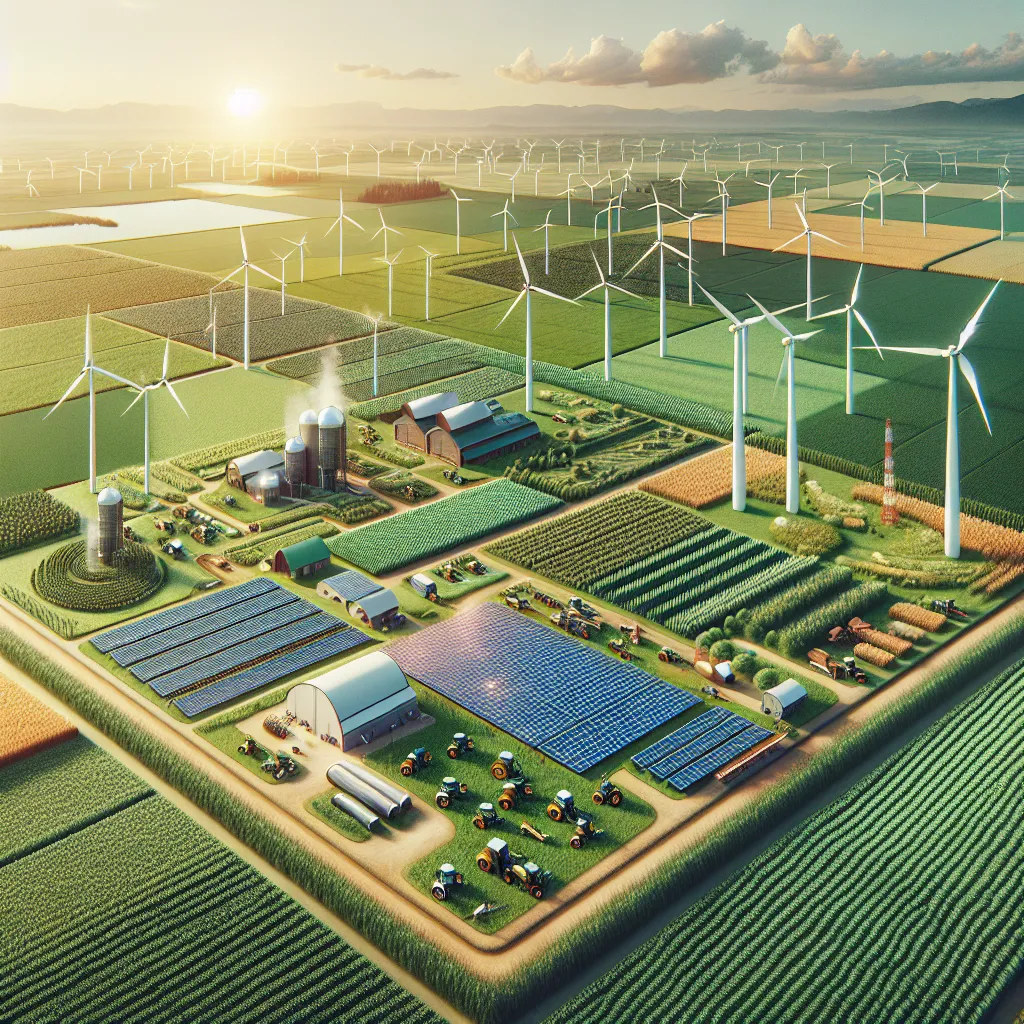Welcome to our IELTS Reading practice test focusing on “The Role of Renewable Energy in Modern Agriculture.” This comprehensive test will help you prepare for the IELTS exam by providing a realistic experience of the Reading section. Let’s dive into the world of sustainable farming and clean energy!
 Renewable energy in agriculture
Renewable energy in agriculture
Introduction
The IELTS Reading test consists of three passages of increasing difficulty. Today, we’ll explore how renewable energy is transforming agricultural practices, reducing carbon footprints, and enhancing farm efficiency. This topic is not only relevant for your IELTS preparation but also crucial for understanding the future of sustainable food production.
Passage 1 (Easy Text)
Solar-Powered Farms: A Bright Future for Agriculture
The integration of solar power into farming practices is revolutionizing the agricultural sector. Photovoltaic panels are becoming a common sight on barn roofs and in fields, providing a clean and sustainable energy source for various farm operations. This shift towards solar energy is not only reducing operational costs for farmers but also minimizing the environmental impact of agricultural activities.
One of the most significant advantages of solar power in agriculture is its ability to operate irrigation systems. Solar-powered pumps can draw water from wells or reservoirs, ensuring crops receive adequate hydration even in remote areas without access to the electrical grid. This innovation has been particularly transformative in developing countries, where reliable power supply is often a challenge.
Moreover, solar energy is being harnessed to power greenhouses, extending growing seasons and enabling year-round crop production in colder climates. These solar greenhouses use passive solar design principles to maximize heat retention and light penetration, creating optimal conditions for plant growth while minimizing energy consumption.
The adoption of solar technology in agriculture also contributes to the concept of “agrivoltaics” – the simultaneous use of land for both solar energy production and agriculture. This dual-use approach allows farmers to generate clean electricity while continuing to grow crops or graze livestock, effectively increasing land productivity.
As the cost of solar technology continues to decrease and efficiency improves, more farmers are expected to embrace this renewable energy source. The solar-powered farm of the future promises to be more sustainable, resilient, and economically viable, setting a new standard for modern agriculture.
Questions 1-5
Do the following statements agree with the information given in the passage?
Write:
- TRUE if the statement agrees with the information
- FALSE if the statement contradicts the information
- NOT GIVEN if there is no information on this
- Solar panels are exclusively installed on barn roofs in farms.
- Solar-powered pumps have made irrigation possible in areas without electricity.
- Solar greenhouses can only be used in warm climates.
- Agrivoltaics allows for the dual use of land for energy production and farming.
- The government provides subsidies for farmers to install solar panels.
Questions 6-10
Complete the sentences below.
Choose NO MORE THAN TWO WORDS from the passage for each answer.
- Solar power in agriculture helps reduce both operational costs and ____ ____.
- In developing countries, solar-powered pumps help overcome the challenge of unreliable ____ ____.
- Solar greenhouses use ____ ____ ____ principles to create ideal growing conditions.
- The combination of solar energy production and agriculture on the same land is known as ____.
- As solar technology becomes cheaper and more efficient, it is expected to set a new ____ for modern agriculture.
Passage 2 (Medium Text)
Wind Energy: Harnessing the Breeze for Agricultural Needs
The utilization of wind energy in agriculture represents a significant stride towards sustainable farming practices. Wind turbines, once primarily associated with large-scale energy production, are now finding their place on farms across the globe. This transition is driven by the need for cost-effective, clean energy solutions that can support the diverse and energy-intensive operations of modern agriculture.
Wind power offers several unique advantages to farmers. Unlike solar energy, wind turbines can generate electricity around the clock, provided there is sufficient wind. This consistent energy production is particularly valuable for farms with continuous power requirements, such as dairy operations that need constant refrigeration or livestock facilities requiring ventilation and climate control.
The vertical axis wind turbines (VAWTs) are gaining popularity in agricultural settings due to their compact design and ability to operate in turbulent wind conditions often found around farm buildings. These turbines can be installed closer to the ground and require less maintenance than their larger, horizontal-axis counterparts, making them an attractive option for small to medium-sized farms.
Wind energy is also playing a crucial role in water management on farms. Wind-powered water pumps, a technology that has been used for centuries, are experiencing a resurgence in modern form. These systems can pump water from wells, rivers, or reservoirs for irrigation, livestock watering, and other farm uses without relying on grid electricity or fossil fuels.
Furthermore, the integration of wind energy into farming practices contributes to the concept of “energy farming.” Farmers can lease portions of their land for wind turbine installation, creating an additional revenue stream while continuing their agricultural activities. This diversification of income can provide financial stability, especially during years of poor crop yields or low market prices.
However, the adoption of wind energy in agriculture is not without challenges. The initial investment costs can be substantial, and the suitability of wind power depends heavily on local wind resources. Additionally, concerns about noise pollution and visual impact must be addressed, particularly in areas where turbines might affect local wildlife or scenic views.
Despite these challenges, the potential of wind energy in agriculture is immense. As technology advances and becomes more affordable, wind power is poised to play an increasingly important role in creating sustainable, energy-independent farms of the future.
Questions 11-14
Choose the correct letter, A, B, C, or D.
-
According to the passage, wind energy in agriculture is valuable because:
A) It is cheaper than all other energy sources
B) It can provide power continuously if wind is available
C) It requires no maintenance
D) It is supported by government subsidies -
Vertical axis wind turbines (VAWTs) are suitable for farms because:
A) They are more powerful than horizontal turbines
B) They are cheaper to install
C) They can operate in turbulent wind conditions
D) They are invisible to wildlife -
The concept of “energy farming” refers to:
A) Using energy crops for biofuel production
B) Maximizing energy efficiency on farms
C) Leasing land for wind turbine installation
D) Selling excess energy back to the grid -
Which of the following is NOT mentioned as a challenge for wind energy adoption in agriculture?
A) High initial costs
B) Dependence on local wind conditions
C) Potential noise pollution
D) Lack of technical expertise among farmers
Questions 15-19
Complete the summary below.
Choose NO MORE THAN TWO WORDS from the passage for each answer.
Wind energy is becoming increasingly important in sustainable agriculture. It offers advantages such as 15____ energy production, which is beneficial for farms with continuous power needs like 16____ and livestock facilities. 17____ are becoming popular on farms due to their compact design. Wind power also aids in 18____, with modern versions of wind-powered water pumps being used for various farm activities. The integration of wind energy allows farmers to participate in 19____, providing an additional source of income.
Passage 3 (Hard Text)
Bioenergy: Cultivating Power from Agricultural Waste
The concept of bioenergy in agriculture represents a paradigm shift in how we perceive and utilize agricultural waste. This renewable energy source, derived from organic materials, is rapidly gaining traction as a sustainable solution to meet the energy demands of modern farming while simultaneously addressing waste management challenges. The symbiotic relationship between bioenergy production and agriculture offers a compelling model for circular economy principles in the farming sector.
Bioenergy encompasses a diverse range of technologies and processes, each tailored to convert different types of biomass into usable energy forms. Anaerobic digestion, a process that breaks down organic matter in the absence of oxygen, is particularly relevant in agricultural contexts. This technology can transform livestock manure, crop residues, and food processing waste into biogas, a versatile fuel that can be used for heating, electricity generation, or even as a transportation fuel when refined into biomethane.
The implementation of anaerobic digestion systems on farms creates a closed-loop energy cycle. The biogas produced can power farm operations, while the nutrient-rich digestate – a byproduct of the process – serves as an excellent organic fertilizer. This not only reduces dependence on synthetic fertilizers but also mitigates the environmental impact of agricultural waste disposal.
Another promising avenue in agricultural bioenergy is the cultivation of energy crops. These are fast-growing plants specifically grown for energy production, such as miscanthus, switchgrass, or short-rotation coppice willow. When integrated into existing farming systems, energy crops can provide numerous benefits beyond energy production. They can act as windbreaks, reduce soil erosion, enhance biodiversity, and even remediate contaminated soils through phytoremediation.
The concept of agro-forestry for bioenergy production is gaining momentum, particularly in temperate climates. This approach integrates woody biomass production into agricultural landscapes, creating multi-functional land use systems. By incorporating trees or shrubs into croplands or pastures, farmers can produce biomass for energy while benefiting from improved soil health, carbon sequestration, and diversified income streams.
Advanced thermochemical conversion technologies, such as pyrolysis and gasification, are expanding the potential of agricultural biomass utilization. These processes can convert a wide range of feedstocks into high-value products like bio-oil, syngas, and biochar. Biochar, a carbon-rich material, has garnered significant interest for its potential to enhance soil fertility and act as a long-term carbon sink, aligning agricultural practices with climate change mitigation efforts.
However, the large-scale adoption of bioenergy in agriculture faces several challenges. The competition for land use between food production and energy crops remains a contentious issue, particularly in regions facing food security concerns. Additionally, the economic viability of bioenergy systems often depends on policy support and incentives, as the initial capital costs can be substantial.
The sustainability of bioenergy production also requires careful consideration of the entire life cycle, including biomass cultivation, harvesting, and processing. Ensuring that bioenergy systems result in net positive energy balances and genuinely reduce greenhouse gas emissions is crucial for their long-term viability and acceptance.
Despite these challenges, the integration of bioenergy into agricultural systems offers a promising pathway towards more sustainable and resilient farming practices. As technology advances and policies evolve to support renewable energy adoption, bioenergy is poised to play an increasingly significant role in the future of agriculture, contributing to both energy security and environmental stewardship.
Questions 20-23
Choose the correct letter, A, B, C, or D.
-
According to the passage, which of the following is NOT a benefit of anaerobic digestion in agriculture?
A) Production of biogas for energy
B) Creation of organic fertilizer
C) Reduction of synthetic fertilizer use
D) Increase in crop yields -
Energy crops are described in the passage as:
A) Slow-growing plants used for food production
B) Fast-growing plants specifically for energy production
C) Plants that require high levels of fertilizer
D) Crops that can only be grown in tropical climates -
The concept of agro-forestry for bioenergy production involves:
A) Clearing forests for agricultural use
B) Growing only trees for biomass
C) Integrating woody biomass production into agricultural landscapes
D) Replacing all crops with energy crops -
Which of the following is mentioned as a challenge for large-scale adoption of bioenergy in agriculture?
A) Lack of suitable biomass sources
B) Competition for land use with food production
C) Insufficient technology for biomass conversion
D) Overproduction of energy from biomass
Questions 24-26
Complete the sentences below.
Choose NO MORE THAN TWO WORDS from the passage for each answer.
- The nutrient-rich byproduct of anaerobic digestion, called ____, can be used as an organic fertilizer.
- Energy crops can help in cleaning contaminated soils through a process known as ____.
- Advanced technologies like pyrolysis can convert agricultural biomass into products such as bio-oil, syngas, and ____.
Questions 27-30
Do the following statements agree with the claims of the writer in the passage?
Write:
- YES if the statement agrees with the claims of the writer
- NO if the statement contradicts the claims of the writer
- NOT GIVEN if it is impossible to say what the writer thinks about this
- Bioenergy production in agriculture always results in a net positive energy balance.
- The economic viability of bioenergy systems is independent of government policies and incentives.
- Biochar has the potential to improve soil fertility and act as a carbon sink.
- The integration of bioenergy into agricultural systems is likely to increase in the future.
Answer Key
Passage 1
- FALSE
- TRUE
- FALSE
- TRUE
- NOT GIVEN
- environmental impact
- power supply
- passive solar design
- agrivoltaics
- standard
Passage 2
- B
- C
- C
- D
- consistent
- dairy operations
- Vertical axis wind turbines
- water management
- energy farming
Passage 3
- D
- B
- C
- B
- digestate
- phytoremediation
- biochar
- NO
- NO
- YES
- YES
This IELTS Reading practice test on “The Role of Renewable Energy in Modern Agriculture” provides a comprehensive overview of how various forms of clean energy are transforming farming practices. By mastering the content and question types presented here, you’ll be well-prepared for similar topics in the actual IELTS exam.
Remember to practice time management, as you’ll have only 60 minutes to complete all three passages in the real test. Focus on improving your skimming and scanning skills to quickly locate relevant information.
For more practice on related topics, check out our articles on how renewable energy is driving innovation in tech and the impact of renewable energy on local communities.
Keep practicing, and good luck with your IELTS preparation!


